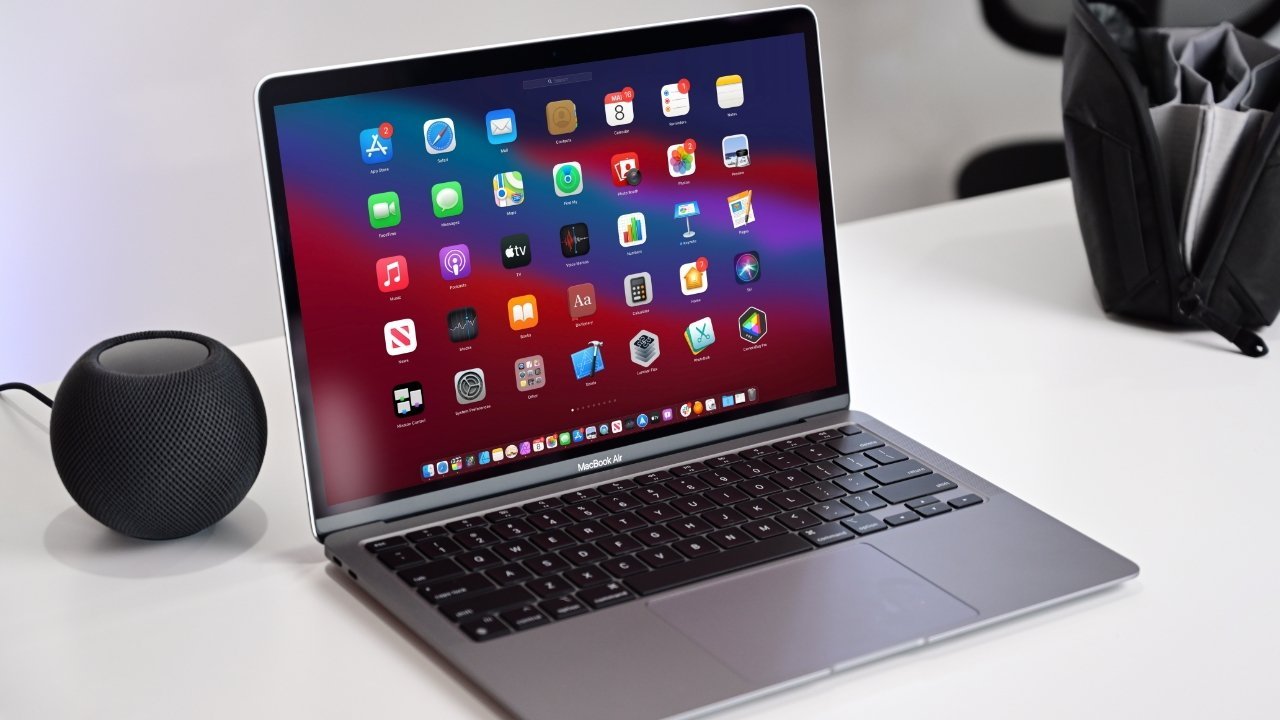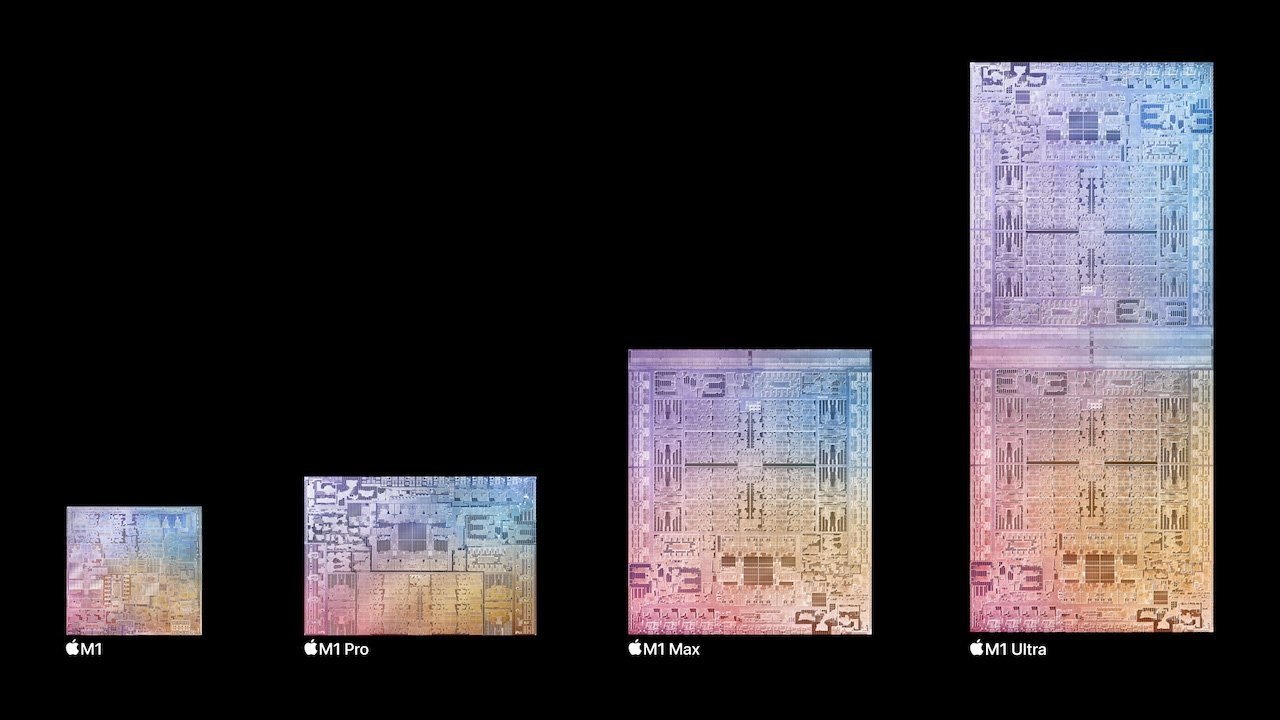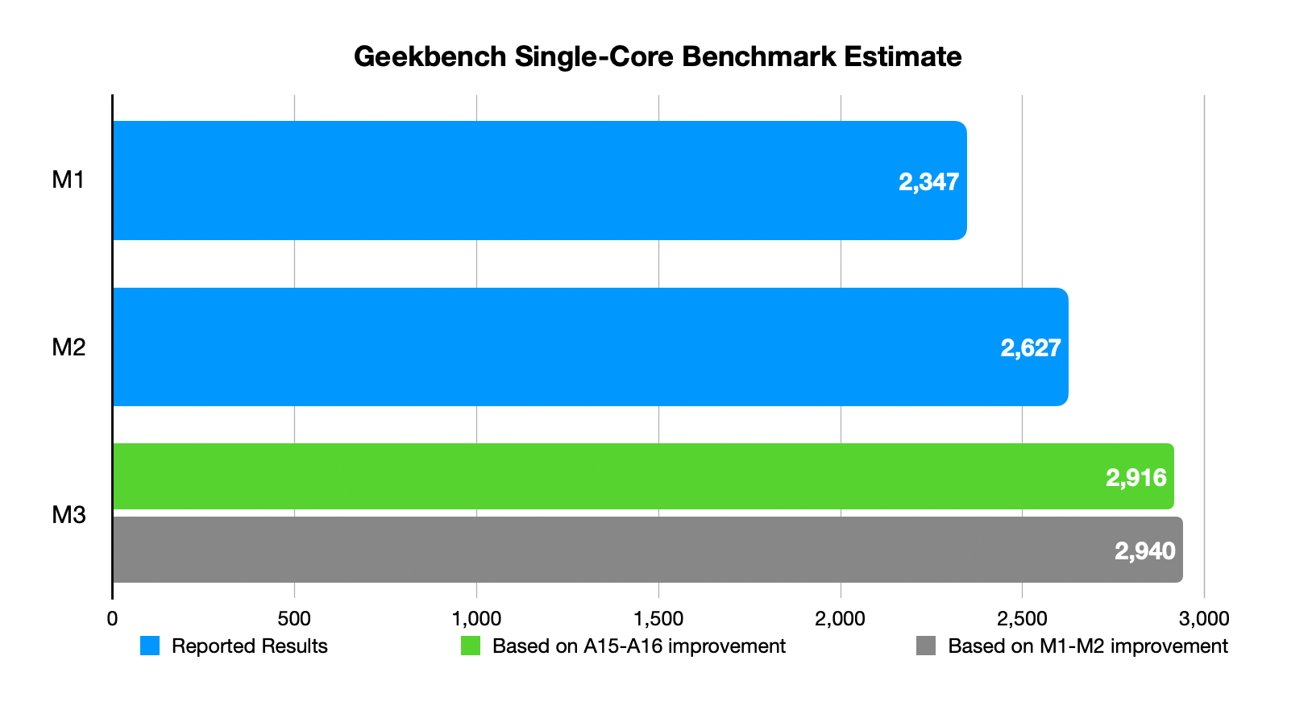Apple has completed its M2 lineup and is expected to bring out M3 within months. This is what the next Apple Silicon generation can offer over M2.
Apple's introduction of new Mac models at WWDC using the M2 Ultra means it has completed its lineup of M2 chips. With the release of the M2, M2 Pro, M2 Max, and M2 Ultra, Apple has filled out the generation with the same variants as its original M1.
Though there's a slim chance that Apple could add more to the lineup, the rumor mill is quite sure that the M2 is complete, and that the M3 generation is the next future upgrade for Apple Silicon.
Apple did a lot with its M2 upgrade from M1, and with the prospect of M3 arriving soon, it's worth trying to guess what Apple could actually come up with for the chip lineup.
Here, then, is AppleInsider's best guess of what could be on the way, based on rumors and some educated guesses.
When is M3 coming out?
The easiest thing to consider is when Apple could bring out the M3 lineup. With the effective completion of M2, the first M3 could easily arrive within a few quarters.
Rumors about the chip claim that, with the 24-inch iMac missing out on M2, it is likely to skip ahead and become one of the first Macs running on M3. An October launch, as part of Apple's typical fall release schedule, has already been declared.
Other candidates for the M3 treatment include the 13-inch MacBook Air and the 13-inch MacBook Pro. Lobbing M3 into the Mac mini isn't entirely out of the realm of possibility, either.
There's always a chance Apple could push the launches into early 2024, if it felt the need to give the M2 a bit more space to exist on the market before effectively becoming out of date. But then again, that would mean a whole six months to wait for a new Mac launch, which seems unlikely.
M2 vs. M3: A whole new generation
Apple is a creature of habit, and it likes to keep things extremely regular. This takes many forms, including the components used in its various products, and this also extends to its chip lineups.
The M1 lineup was made up of the original M1, followed by the M1 Pro and M1 Max which added more cores and other elements. Then there was the M1 Ultra, which took the M1 Max and doubled everything because it was literally two M1 Max chips connected together.
That pattern continued with M2, as the M2 Pro and M2 Max also added more CPU and GPU cores, higher memory options, and better performance. Again, M2 Ultra used the same playbook as the M1 version, combining the power of two M2 Max chips.
Given Apple's willingness to follow a theme, it's very likely that the M3 will go the same way. After an initial M3 release wave, Apple will then take a few months to bring out Macs and MacBooks running M3 Pro and M3 Max, and then eventually an M3 Ultra.
For the purposes of this article, we will be discussing just what the M3 could look like. It's safe to say that M3 Pro, Max, and Ultra will have more cores and better performance, but they will be further out on the release schedule.
Besides, in estimating how much better M3 should be over the M2, it should offer some general idea of how the rest of the generation should go.
M2 vs. M3: Look at how the M1 derived from the A14 Bionic
It's common knowledge that Apple used its A-series experience to design the M-series chips. Indeed, if you look at the last few generations of A-series chips, you may spot a pattern emerging.
The M1 shares many similarities with the A14 Bionic, the chip Apple released one quarter before its first Apple Silicon Mac.
The similarities start with the CPU, which uses the same type of cores across both generations. Sure, Apple uses two performance Firestorm cores and four Icestorm efficiency cores in the A14, it goes for four Firestorm cores and four Icestorm cores in the M1.
Along with two more performance cores, the M1 also clocks them higher, due to the greater potential to thermally manage the chips. The Firestorm cores go from 3GHz to 3.2GHz from A14 to M1, and Icestorm goes from 1.82GHz to 2.06GHz.
There are other coincidences too, such as the use of 5-nanometer production processes, and similar 16-core 11 trillion operations per second Neural Engines. While single-channel memory results in 34.1GB/s of memory bandwidth in the A14, the dual-channel memory in M1 has 68.25GB/s, double the amount.
This isn't just limited to the M1, as the same sort of thing can be observed with the M2 and the A15 Bionic.
M2 vs M3: Likewise, the M2 sprung from the A15 Bionic
Again, there's a CPU core count increase from 6 in the A15 to 8 in the M2, with two more performance cores being used. The two Avalanche performance cores and four Blizzard efficient cores in the A15 are countered by a four and four grouping in the M2 of the same core types.
Due to thermal management improvements, there's another performance gain for the M2, from 3.23GHz to 3.5GHz for the Avalanche cores and 2.02 to 2.8GHz for the Blizzard.
While variances in clock speed between generations can be a clue to improved performance, improvements in core design can also help bump up the processing potential of a CPU.
 An illustration of the A15 Bionic, as used in the iPhone 13 generation, as well as the iPhone 14 and 14 Plus
An illustration of the A15 Bionic, as used in the iPhone 13 generation, as well as the iPhone 14 and 14 PlusThe Neural Engine is, again, identical across the two at 16 cores running at 15.8 TOPS. Apple also doubles the GPU core count, with the A15's 5 GPU cores replaced by a 10-core version in the M2.
The comparison does break down slightly for memory, as Apple does limit the bandwidth to 34.1GB/s on the A15, but the M2 offers up to 100GB/s. It is more probable that the A-series is limited by the memory it uses, rather than Apple increasing the bandwidth beyond switching from single-channel to dual-channel memory.
M2 vs M3: Extrapolating M3
If Apple is following the same sort of pattern for the M3, we must logically look to the A16 Bionic for its next iteration of Apple Silicon chip.
We know that the A16 Bionic uses six cores for the CPU, consisting of two Everest performance cores clocked at 3.46Hz and four Sawtooth efficiency cores at 2.02GHz. It wouldn't be unexpected for Apple to move to four Everest and four Sawtooth cores for M2, with a modest upgrade in clock speeds to around 3.7GHz and 3GHz respectively.
Since A16 uses a 17 TOPS 16-core Neural Engine, we can expect Applet to stick to what works and to use the same thing in the M3.
On the memory side, Apple still uses single-channel memory in the A16, with over 50GB/s of bandwidth available. Using double-channel in the M3, 100GB/s would be a minimum for Apple to use, though it could again go a bit higher.
Apple's continued use of a 5-core GPU in the A16 may get a doubling yet again in the M3 to 10 cores but at a higher clock speed than the previous generation. That is if Apple doesn't design in more cores anyway.
M2 vs. M3: Outlier features
There are some areas that an A-series comparison cannot cover, or that Apple could wildly depart from, if you believe rumors.
For a start, there are its Unified Memory capacities. While M1 uses 8GB and 16GB capacities with M2 extending that range to include 24GB as a third option, Apple may go one step beyond and hit 32GB for the M3.
While the M1 is the only chip in Apple Silicon to not have any form of Media Engine for video encoding and decoding, Apple's inclusion of it in M2 probably means it's a feature that could stick around for M3. Apple could stick to what works in the M2, though it could add more engines to improve the generation's capabilities.
Then there's the manufacturing process, which is another problem for predictions. Apple used a 5-nanometer process to make its A14 and A15 chips, as well as the M1 and M2.
When it comes to the A16, Apple uses a 4-nanometer process instead. Though Apple could use that for the M3, some early rumors pointed to Apple switching to a 3-nanometer process for both A17 and M3.
Later supply chain rumors in April claimed the shift to 3-nanometer was having teething issues, but that it was still going to be used for M3 after TSMC apparently dedicated the entire production run for Apple in February.
Going to 3nm could give Apple considerable benefits for M3, including performance boosts of around 15% at comparative power levels to 5nm counterpart chips, or a 35% reduction in power consumption for comparable performance.
M2 vs. M3: Better performance
With Apple's introduction of a third generation of chip, it's almost certain that there will be some form of performance improvement along the way. We just don't know by how much.
The most obvious way to compare is to look at what Apple itself says about going from M1 to M2. At launch, this included claims of "an 18% faster CPU, a 35% more powerful GPU, and a 40% faster Neural Engine."
Working out where the M3 could take performance could be of a similar level once again. Though, with changes in nanometer and unanswered questions about memory bandwidth, the changes could be considerably larger.
Seeing as we have already raised the A-series chips as a point of comparison, examining the iPhone lineup could give some idea of what to expect.
Under the Geekbench Browser for iPhone benchmarks, the iPhone 14 Pro Max's A16 has a single-core score of 2,509, a multi-core score of 6,317, and a Metal score of 22,236.
This is an 11% rise in single-core performance from 2,259 for the A15 in the iPhone 13 Pro Max. For multi-core, it's 16% up from the iPhone 13 Pro Max's 5,418 result, and 11% again from the 19,907 Metal score.
That iPhone 13 Pro Max saw gains from the iPhone 12 Pro Max and its A14 Bionic chip. Single-core performance in the A14 rose 10% from the A13's 2,039 score, multi-core saw a 17% rise from 4,620, and a 24% gain from the 15,983 Metal score.
While the gains from the A15 to A16 are promising, they aren't directly comparable to the M2-M3 changeover. Differences such as switching from single-channel memory to dual-channel, variances in core counts, and thermal management changes can considerably vary the score progression.
If we looked at the percentage gain in score for single-core performance, there's a fairly similar gain between the M1 and M2, and if you look at the A15 and A16. This is to be expected, given CPU gains aren't typically as massive as GPU or multi-core improvements between generations.
Over to the GPU side, and comparing the performance has a lot more variance when it comes to the M3. The equivalent A15 to A16 improvement of 11% for Metal is good, but then there's the 25% boost if you look at A14 to A15.
But if you look at the improvement from M1 to M2, that's a 37% gain. In Metal score terms, that would put the M3's GPU capabilities at around double that of the M1 if the improvement from M2 to M3 mirrored that of the M1 to M2.
Since we don't know enough about the chips, we can't give a more definitive result than this. At least, until Apple brings the chips out.
By using a similar structure to the A16, including the same types of cores, it's certainly plausible that a 10% or greater performance boost over the M2 could be achieved for the CPU, and even more for the GPU. It's not an entirely accurate method, and not exactly guaranteed against what Apple eventually releases to the world, but it's a good starting point for further consideration.
All we can really be sure of is that M3 will be Apple's best Apple Silicon chip generation yet.
 Malcolm Owen
Malcolm Owen














-m.jpg)






 Brian Patterson
Brian Patterson
 Christine McKee
Christine McKee
 Andrew O'Hara
Andrew O'Hara



 William Gallagher
William Gallagher








17 Comments
I think there is a chance that they decide to choose an A17 chip design for M3. Seems like using A16 is too small of a performance jump unless Apple decides to make an A16.5 which would be like A16 but in 3nm who knows besides Apple
This article would benefit from adding a bit more detail with regard to the TSMC process nodes used. One thing the A14/M1 and A15/M2 history does support is the idea that A16/M3 or A17/M3 will have the same process node:
A17 is likely to look as follows: A17 (September 2023) [TSMC 3nm gen1 "N3 (or N3E)"]
Sure, anything is possible, and it's a legitimate question to wonder if A16 or A17 will be the foundation for M3, but if it is A16 then it will be N4 (5nm generation 3, so-called "4nm"). It will not be 3nm. If it is 3nm, then it will be based on the A17 and TSMC N3 (or N3E). I find it very difficult to believe that Apple would not have already tamped down the rumors surrounding M3 on 3nm if that was not going to happen, and as far as I know there has been nothing to stem the tide. I mean, they just reached out to Gurman to get him to remind people that the Pro/Max variants come months after the initial M release, and no one should be expecting them this year, or even early next year, even if M3 is launched in October.
Hopefully this is the generation where Apple puts the "Pro" into the Apple Silicon Mac Pro. All the signs point to Apple having planned to have a doubling of the M2 Ultra that due to whatever reason did not ship.